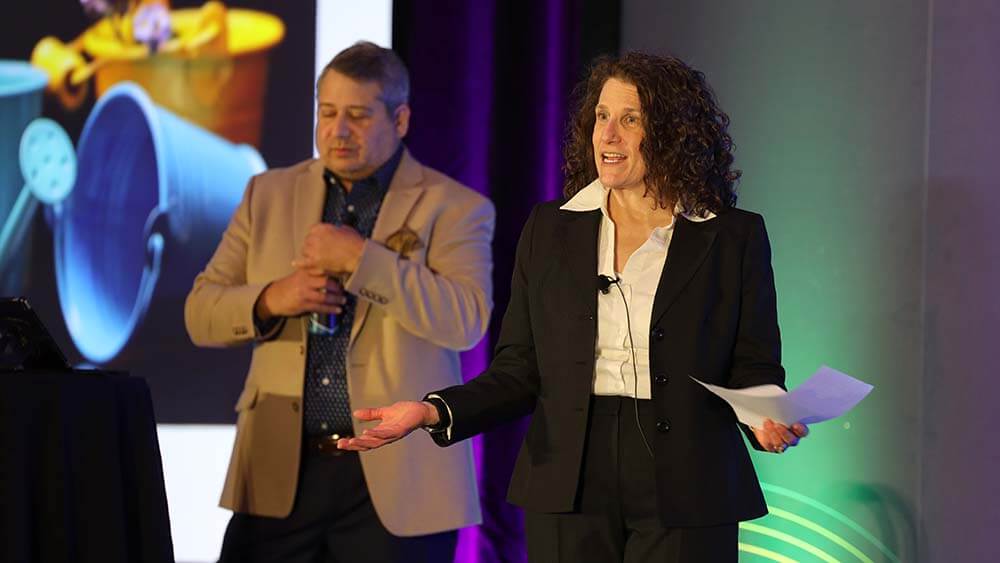
Marketing and accessibility specialist Meryl Evans (right) speaks to a Convening Leaders 2022 audience about making events more inclusive and inviting for attendees with disabilities. (Jacob Slaton Photography)

Beki Winchel
I gained so many insights from working with Meryl Evans in preparation for her Convening Leaders 2022 session, “Demystifying Accessibility: How to Make Sure Your Events and Experiences are Inclusive and Inviting.” Meryl is a marketing and accessibility specialist and trainer and professional speaker who is deaf. Here are four takeaways from my experience working with her that you can apply to make your events — digital and in-person — inclusive:
1. Accessibility isn’t a one-size-fits-all consideration. Only by understanding the unique needs and behaviors of attendees with disabilities can you offer necessary alternatives to make their event experience a positive one. Incorporate an accessibility approach into your registration process by asking attendees if they require accommodations, such as captioning, wheelchair access to workshop tables, assistive listening devices, and more. Adding a notice to your event’s website that announces your intention to host an inclusive and accessible event will also signal your inclusivity and direct attendees with additional requirements to the preferred contact person. Cornell University has a great example of that kind of welcoming message.
Meryl is a deaf lipreader who also uses transcripts to communicate. She doesn’t use American Sign Language (ASL), which presents a challenge at meetings, especially if speakers move around within the audience or on stage. She misses important questions or portions of a keynote address if a speaker’s back is towards her of his or her face is obscured from view. These and other everyday considerations I took for granted before talking with Meryl.
2. Pay attention to the details. Event accessibility should extend to every aspect of an attendee’s experience — including those beyond your meeting’s walls. Just as event planners consider the type of food served, availability of coffee, and alternatives for single-use plastics, we all need to consider how attendees with varying needs will navigate your event.
Watch CL22 Sessions
Convening Leaders 2022 attendees, don’t miss your chance to re-watch Meryl Evans’s sessions and others for education credits in JUNO’s CL22 Library. On-demand access to CL22 content is available through March 12, 2022.
At Convening Leaders 2022, our headquarters hotel Harrah’s placed Meryl in a hearing-impaired room, which offers a TTY (a text telephone device for those with hearing and communication difficulties) and uses lights and vibrations for its fire alarm, doorbell, and alarm clock.
Because Las Vegas’s mask mandate was in effect for Convening Leaders — making lipreading an impossibility — a member of the PCMA team met Meryl and assisted her through the registration process on site, using text messages to communicate along the way. For her session, we took attendee questions in the Q&A portion through the virtual event JUNO app, but a back-up moderator was prepared to take questions from the audience and repeat them, unmasked and socially distanced near the stage.
3. Technology can be both a saving grace and a pitfall. Tech can help overcome communication and accessibility gaps, but it’s not a replacement for human understanding attendees and providing for their needs. Just as you seek data and feedback to know what agenda formats, event space designs, and session lengths fit attendee behaviors and needs, do the same for those with disabilities. Accessibility concerns also apply to virtual and hybrid events, and many organizations can make their websites, digital meetings, and social media content more inclusive. Consider this thorough collection of resources for social media accessibility by accessibility marketing expert Alexa Heinrich and digital agency Diamond’s 2021 State of Accessibility Report.
When talking with Meryl virtually, auto-captioning will only go so far. Often, it makes mistakes with names and will misinterpret phrases, so repeating and understanding context is necessary. Meryl also told me that many apps aimed at overcoming communication gaps “puts the onus on the deaf person and it’s not discreet.” She explains more in a LinkedIn post, and advises organizations to offer participants two options for contacting them — not just a phone number, but via email and/or text.
4. Aim to over-communicate and prepare. Event professionals are often already adept at communicating and preparing for several contingencies, and this skill should be extended to accessibility efforts. Straightforward and proactive communication — and reminders — can ensure that you’re truly and authentically providing an inclusive experience for everyone, as well as minimizing problems during the event.
My open communication with Meryl, through both email and text, allowed us to prepare for her arrival, answer questions and concerns, learn of challenges beforehand, and quickly respond to any issues that arose. When I was in doubt, I asked Meryl, who was more than willing to share her needs, as well as give me additional context and information to help me better understand existing challenges and ideas for overcoming them.
Beki Winchel is PCMA’s learning content and research developer.
